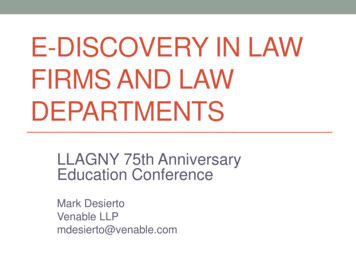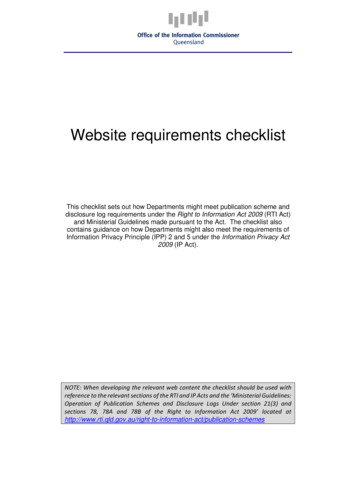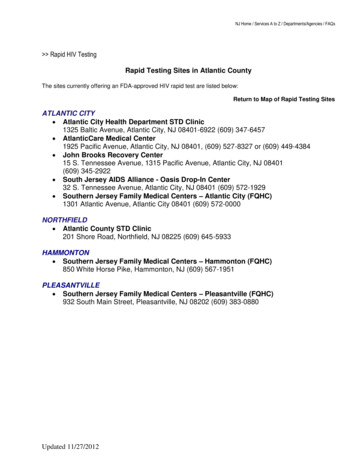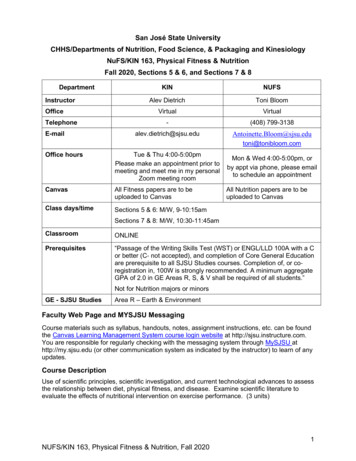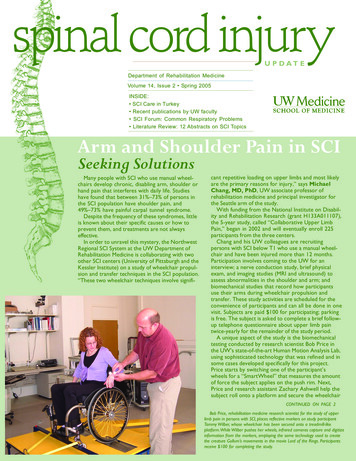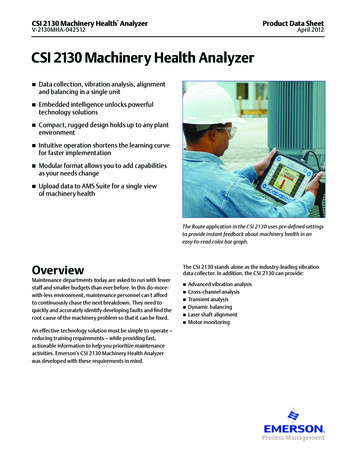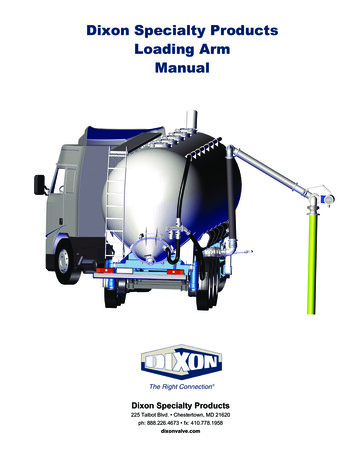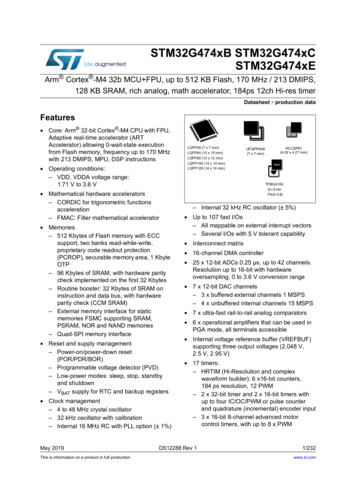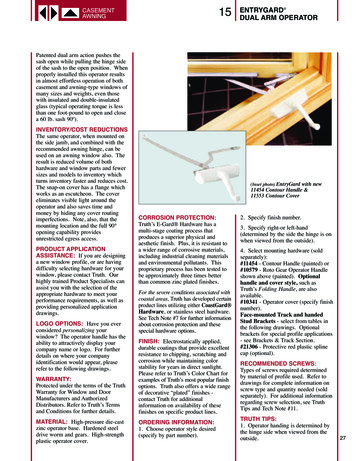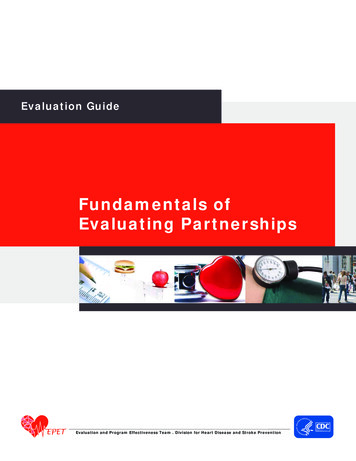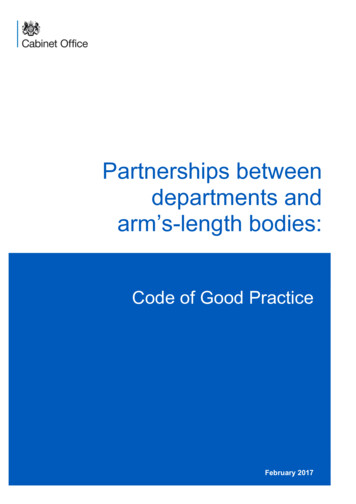
Transcription
Partnerships betweendepartments andarm’s-length bodies:Code of Good PracticeFebruary 2017
Partnerships betweendepartments andarm’s-length bodies:Code of Good PracticeFebruary 2017
This document is available in large print,audio and braille on request. Please call020 7271 0852 or emailpublicbodiesreform@cabinetoffice.gov.uk Crown copyright 2017This publication is licensed under the terms ofthe Open Government Licence v3.0 exceptwhere otherwise stated. To view this licence,visit /version/3 or write to theInformation Policy Team, The NationalArchives, Kew, London TW9 4DU, or email:psi@nationalarchives.gsi.gov.uk.Where we have identified any third partycopyright information you will need to obtainpermission from the copyright holdersconcerned.Any enquiries regarding this publication shouldbe sent to us atpublicbodiesreform@cabinetoffice.gov.ukThis publication is available atwww.gov.uk/government/publicationsPrinted on paper containing 75% recycled fibrecontent minimum.
Partnerships between departments and arm’s-length bodies: Code of Good Practice 1ContentsAbout this Code3Introduction3The four principles4How this Code should be used5Scope of the Code61. Purpose72. Assurance83. Value104. Engagement11Annex A – Code of Good Practice Working Group membership12
2 Partnerships between departments and arm’s-length bodies: Code of Good Practice
Partnerships between departments and arm’s-length bodies: Code of Good Practice 3About this CodeIntroduction“Arm’s-length bodies represent an extension of the department’s delivery, so really weshould think about a department and its arm’s-length bodies as a total delivery system.For the system to work well, the relationship between a department and its bodiescannot be just about oversight. An effective partnership must be based on trust, clarityof accountability, and a shared understanding of purpose and outcomes.”John Manzoni, Chief Executive of the Civil Service and Cabinet Office PermanentSecretaryEffective relationships between departments and arm’s-length bodies are critical to thedelivery of high quality public services.This Code aims to bring greater consistency to relationships between departments andarm’s-length bodies. It was developed in response to reports by the National Audit Office1and the Public Accounts Committee,2 which recommended that the varied approachesdepartments took to managing relationships with arm’s-length bodies should beunderpinned by common principles based on learning of what works well.Within this model the Code recognises that partnerships will vary according to thepurpose, size, structure and public interest in the body. However, whilst partnerships willvary, all effective partnerships will be underpinned by common principles: the purpose ofthe arm’s-length body should be clear and well understood; there should be aproportionate approach to assurance; departments and arm’s-length bodies should shareskills and experience; and most importantly, partnerships should be based on open,honest and constructive working relationships.The Code sets out these common principles. Departments and arm’s-length bodies shouldensure that they comply with them in order to develop effective partnerships. However,within the principles, and in consultation with arm’s-length bodies, it is for departments todetermine the most appropriate model of partnership. There is “no one size fits all”3 topartnerships between departments and arm’s-length bodies.123National Audit Office, ‘Departments’ oversight of arm’s-length bodies: a comparative study’, July 2016.Public Accounts Committee, ‘Departments’ oversight of arm’s-length bodies’, October 2016.Ibid.
4 Partnerships between departments and arm’s-length bodies: Code of Good PracticeThe four principlesThe principles have been developed collaboratively by a working group comprised ofrepresentatives from government departments and arm’s-length bodies.4 The principlesare:PURPOSEPartnerships work well when the purpose, objectives and roles of arm’s-length bodiesare mutually understood; reviewed on a regular basis; and clearly set out in relevantdocuments. There is absolute clarity about lines of accountability between departmentsand arm’s-length bodies. In exercising statutory functions arm’s-length bodies haveclarity about how their purpose and objectives align with those of departments.ASSURANCEPartnerships work well when departments adopt a proportionate approach to assurance,based on arm’s-length bodies’ purpose and a mutual understanding of risk. Arm’s-lengthbodies have robust governance arrangements in place; departments give arm’s-lengthbodies the autonomy to deliver effectively. Management information exists to enabledepartments and arm’s-length bodies to assess performance.VALUEPartnerships work well when departments and arm’s-length bodies share skills andexperience in order to enhance their impact and deliver more effectively. Arm’s-lengthbodies are able to contribute to policy making and broader departmental priorities. Thereis a focus on innovation, and on how departments and arm’s-length bodies worktogether to deliver value for money.ENGAGEMENTPartnerships work well when relationships between departments and arm’s-lengthbodies are open, honest, constructive and based on trust. There is mutual understandingabout each other’s objectives and clear expectations about the terms of engagement.4See Annex A for Working Group membership.
Partnerships between departments and arm’s-length bodies: Code of Good Practice 5The four principles are interrelated, with good Engagement underpinning Purpose,Assurance and Value. Adherence to the principles will PAVE the way for effectivepartnerships between departments and arm’s-length bodies.How this Code should be usedThe Code’s principles are expected to act as a set of common standards for departmentsand arm’s-length bodies to live by and measure their relationships against, on a continuingbasis.Departments and arm’s-length bodies should use this Code of Good Practice to jointlyassess how effective their partnerships are at regular intervals. For example, alignmentwith the Code’s principles could be discussed at regular meetings between departmentsand arm’s-length bodies, to assess the ‘health’ of their continuing relationship. It shouldalso form the basis for any partnership with a newly created arm’s-length body. Theprinciples should be formalised in framework documents and other partnershipagreements.The four principles are based on a number of standards. The standards draw on bestpractice from across government, and whilst they will not all be relevant to everypartnership, they enable departments and arm’s-length bodies to assess the extent towhich they meet each principle.
6 Partnerships between departments and arm’s-length bodies: Code of Good PracticeScope of the CodeThis Code applies to arm's-length bodies as defined in the Cabinet Office ClassificationGuide.5 However, departments may choose to apply the principles and standards set outhere in relation to other bodies where this is relevant. Arm’s-length bodies withsubsidiaries may choose to do the same.The Code complements documents such as Managing Public Money,6 the CorporateGovernance Code for Central Government Departments,7 and other relevant existingguidance.The Code does not override any provisions governing relationships between departmentsand arm’s-length bodies that might exist in statute, or other formal arrangements. In allcases, these existing provisions take primacy.567Cabinet Office, ‘Classification of Public Bodies: information and guidance’, April 2016.HM Treasury, ‘Managing Public Money’, November 2016.HM Treasury, Cabinet Office, ‘Corporate Governance Code for Central Government Departments’,July 2016.
Partnerships between departments and arm’s-length bodies: Code of Good Practice 71. PurposePrinciple1.1 Partnerships work well when the purpose, objectives and roles of arm’s-lengthbodies are mutually understood; reviewed on a regular basis; and clearly set out inrelevant documents. There is absolute clarity about lines of accountability betweendepartments and arm’s-length bodies. In exercising statutory functions arm’s-lengthbodies have clarity about how their purpose and objectives align with those ofdepartments.Standards1.2 The purpose, objectives, accountabilities and roles of the arm’s-length body aremutually understood and clearly defined in relevant documentation, including singledepartmental plans, framework documents and accounting officer system statements.1.3 The framework document (or equivalent) is reviewed and updated regularly, andcomplies with Managing Public Money.81.4 There is an agreed process for reviewing the framework document (or equivalent).Reviews may be required following a significant change in government policy relating tothe arm’s-length body’s business or as a result of a spending review. As a minimum,written agreements should be reviewed formally at least once every three years. A lighttouch annual review for continuing relevance may be useful.1.5 Formal delegations have been established with the arm’s-length body, including theaccounting officer (if appropriate). In such cases the arm’s-length body accounting officerunderstands the conditions of Managing Public Money.91.6 There is a good strategic alignment between the purpose and objectives of the arm’slength body and the department (where appropriate). This is expressed in relevantdocumentation.89HM Treasury, ‘Managing Public Money’, November 2016.Ibid.
8 Partnerships between departments and arm’s-length bodies: Code of Good Practice2. AssurancePrinciple2.1 Partnerships work well when departments adopt a proportionate approach toassurance, based on arm’s-length bodies’ purpose and a mutual understanding of risk.Arm’s-length bodies have robust governance arrangements in place; departments givearm’s-length bodies the autonomy to deliver effectively. Management informationexists to enable departments and arm’s-length bodies to assess performance.Standards2.2 The department's approach to assurance is based on an effective assessment of therisk posed by the arm’s-length body.2.3 The department’s approach to assurance has been agreed with the arm’s-length body,and does not overlap with existing governance arrangements in the body.2.4 The departmental board, the departmental audit and risk committee, and departmentalnon-executive directors have an appropriate overview of operations of the arm’s-lengthbody, proportionate to its purpose, risk and required degree of independence.2.5 The department and the arm’s-length body have a shared understanding of the risksthat may impact on each other, and reflect them appropriately in their respective riskregisters.2.6 The arm’s-length body has established governance arrangements appropriate to itsbusiness and scale. These comply with Managing Public Money.102.7 The department is assured that the arm’s-length body has the right capability to delivereffectively. The arm’s-length body is assured the department has the skills to develop aneffective partnership.2.8 The department and arm’s-length body have access to the data they need to assessthe body’s performance and to drive forward improvements. Where appropriatebenchmarks are used to draw comparisons with other relevant sectors and organisations.10HM Treasury, ‘Managing Public Money’, November 2016.
Partnerships between departments and arm’s-length bodies: Code of Good Practice 92.9 The arm’s-length body, the department, HM Treasury and the Cabinet Office haveagreed what management and financial information will be required over the course of ayear. Central government and the department are mindful of the need to avoid duplicaterequests for the same information, and recognise the need to minimise reporting costs forarm’s-length bodies. The arm’s-length body is clear about why the management andfinancial information is necessary and how it will be used.2.10 The department and the arm’s-length body work with the Cabinet Office and others toparticipate in agreed reviews.
10 Partnerships between departments and arm’s-length bodies: Code of Good Practice3. ValuePrinciple3.1 Partnerships work well when departments and arm’s-length bodies share skills andexperience in order to enhance their impact and deliver more effectively. Arm’s-lengthbodies are able to contribute to policy making and broader departmental priorities.There is a focus on innovation, and how departments and arm’s-length bodies worktogether to deliver value for money.Standards3.2 There is a regular exchange of skills and experience between the department andarm’s-length bodies, different arm’s-length bodies within the departmental group, as wellas arm’s-length bodies outside of the departmental group. This may include secondments,joint programme or project boards, targeted recruitment from staff within bodies or thedepartment, and forums for staff from bodies and departments to learn from each other.3.3 The department and arm’s-length bodies within the departmental group, and arm’slength bodies outside of the departmental group (where relevant), work together in atargeted way on projects according to the expertise and experience required. Departmentsplay a coordinating role to facilitate this.3.4 The department and the arm’s-length body maximise the expertise and experience oftheir non-executive directors. This may include inviting non-executive directors toparticipate in reviews of arm’s-length bodies as well as broader corporate priorities acrossthe integrated delivery system. Departments may also consider inviting the non-executivedirectors of arm’s-length bodies to sit on departmental boards.3.5 Where appropriate, the arm’s-length body is involved as a partner in policydevelopment and provides advice on policy implementation.
Partnerships between departments and arm’s-length bodies: Co
An effective partnership must be based on trust, clarity of accountability, and a shared understanding of purpose and outcomes.” John Manzoni, Chief Executive of the Civil Service and Cabinet Office Permanent Secretary . 4 Partnerships between departments and arm’s-length bodies: Code of Good Practice The four principles The principles have been developed collaboratively by a working group .

